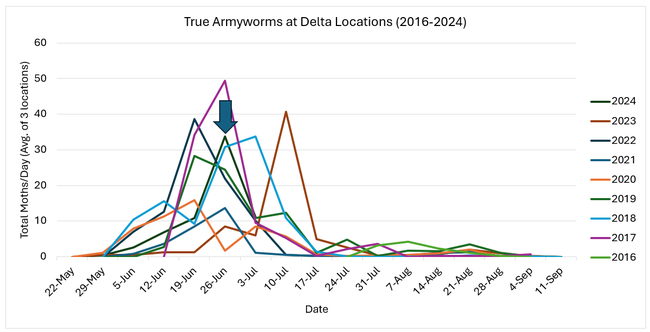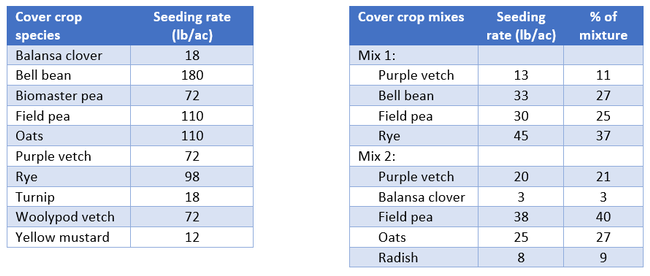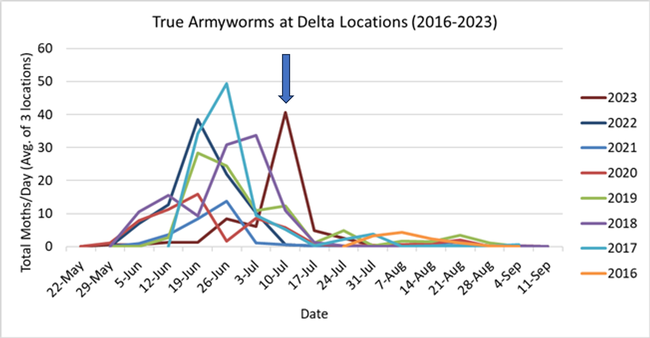- Author: Michelle Leinfelder-Miles
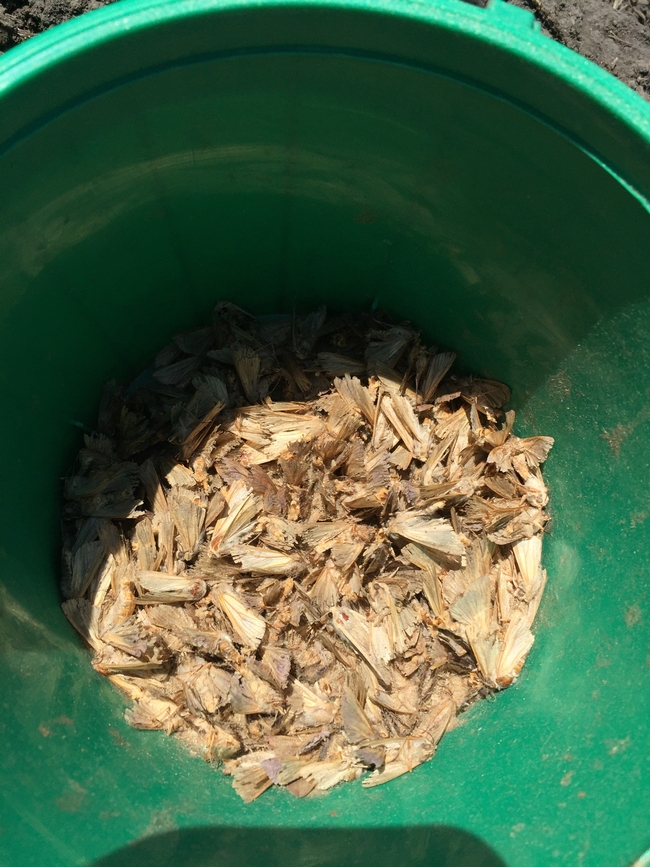
Figure 2 shows monitoring data since 2016 when I began trapping in the Delta. Data are expressed as moths caught per day, averaged across all nine Delta traps. Notice the large arrow indicating the 2024 trend line and how it compares to previous years. While this year appears to be a high-population year, I have noticed variability among the sites where we trap. At one of the three locations, the population peaked at only 9 moths per day, but at the other two locations, the populations peaked at over 40 moths per day. Therefore, it's important to get into the field and look for feeding damage before making a treatment decision.
We reached the peak moth flight last week. Our years of monitoring experience indicates that, if treatment thresholds are met, the optimum time to spray is between one to two weeks after the peak population. So, this would be the week to check your fields for feeding damage and treat as necessary. Please don't hesitate to reach out to me if you have any questions about the IPM guidelines or would like to further discuss this work.
- Author: Michelle Leinfelder-Miles
With funding from the CDFA Healthy Soils Program and CA Rice Research Board, we are evaluating how well different cover crop species establish, provide soil coverage, affect soil carbon and nitrogen dynamics, and/or impact rice yield in subsequent growing seasons. Since rice may be grown over multiple seasons without rotation, cover crops may provide an opportunity to introduce plant diversity, including nitrogen-fixing legumes. Other potential benefits include increasing soil organic matter, reducing nitrogen loss in the winter, reducing nitrogen inputs during the rice season, and improving rice straw decomposition. While evaluating winter cover crops in the rice system is the primary purpose of the trial, the project has relevance for other annual systems where winter cover cropping may be employed.
The trial took place on Staten Island. We planted the cover crops on November 13th by hand-broadcasting seed over 200-ft2 plots and then gently raking it in. We planted 10 single species and two mixes (Tables 1-2). Each treatment was replicated four times, and the graphs below illustrate cover crop stands over the season (Figs. 1-4).
Table 1. Cover crop species and seeding rates. Table 2. Cover crop mixes and seeding rates.
The 2023-24 winter season started off dry, which worked well for cover crop sowing and establishment. The site received approximately 0.2” of rain within a week of planting and about 0.4” by mid-December. The brassicas emerged quickly and started covering the soil after just one month. More frequent storms started in late December, and the project field was adjacent to fields that were winter-flooded. The combination of rain plus seepage from flooded fields meant the project field stayed quite wet after the new year. The data show that the brassicas did not tolerate the wet conditions, and their stands diminished over time. The two vetches and balansa clover started off slowly but had vigorous stands by early spring, despite the wet conditions. While the bell bean did not provide extensive coverage, it survived the wet conditions and was prominent in the plots. We observed that the grass cover crops (i.e. rye, oats) suffered from bird feeding. Based on our experiences and preliminary data, we share the following ‘lessons learned':
- Timing of operations is critical. Growers should strive to plant winter cover crops as early as conditions allow (e.g. early to mid-November). Drill seeding is more effective (i.e. better stand establishment) than flying on and harrowing in seed.
- Stand establishment is impacted by conditions outside the control of the manager (i.e. weather, herbivory). If neighboring fields will be winter-flooded, having drainage ditches between fields will help cover crop growth.
The project will continue through 2025, and in addition to the Delta site, we are also trialing cover crops in Colusa and Butte counties. Please don't hesitate to reach out if you would like to learn more information about this project.

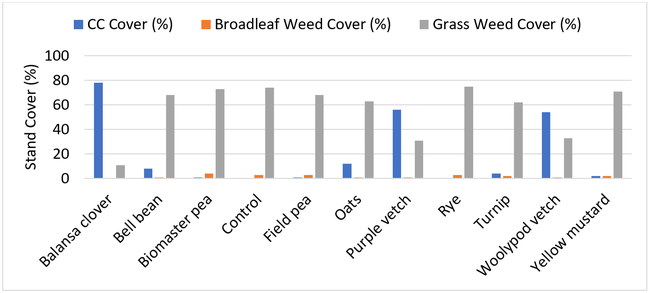
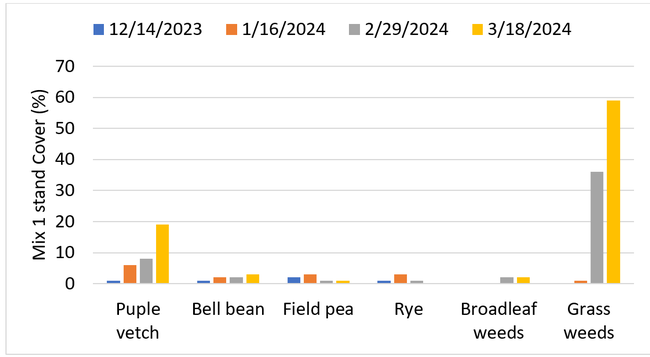


- Author: Michelle Leinfelder-Miles
UC Cooperative Extension will host a Healthy Soils Program field demonstration day on cover cropping in rice systems. The meeting will take place on Thursday, February 29th, from 9:30am to noon, on Staten Island in San Joaquin County (23319 N. Staten Island Road, Thornton). Presentations will describe field trials to evaluate winter cover cropping, incentive programs for growers, and weed management topics ahead of the 2024 growing season. There will also be an opportunity to view different cover crop species for performance. Attendance is free, and registration is not required. CCA continuing education credits will be offered (0.5 PM, 1.0 CM, 0.5 PD). The agenda is pasted below, and a downloadable version is attached. Thanks for your interest in UC Cooperative Extension programming, and we hope to see you later this month!
9:30am Arrive at Staten Island grain silo to sign in (See yellow star on the map)
9:45am Depart to field location – Don't be late!
10:00am Welcome and Introductions: Michelle Leinfelder-Miles, UCCE Delta Region
10:05am Winter Cover Cropping in Rice Systems – Field Demonstrations: Michelle Leinfelder-Miles, UCCE Delta Region
10:20am Cover Crop Variety Evaluations: Sara Rosenberg, UC Davis
10:35am A Grower's Perspective on Cover Crops: Jerred Dixon, Conservation Farms and Ranches
10:55am Healthy Soils Program – Block Grant Pilot Program: Chris Kelley, CA Land Stewardship Institute
11:10am What's New in Rice Weed Management: Whitney Brim-DeForest, UCCE Sutter/Yuba
11:25am Weedy Rice Updates: Whitney Brim-DeForest and Michelle Leinfelder-Miles, UCCE
11:40am Discussion, Viewing of Field Plots, Evaluation
2024 Rice Cover Crop Field Day Agenda FINAL

- Author: Michelle Leinfelder-Miles
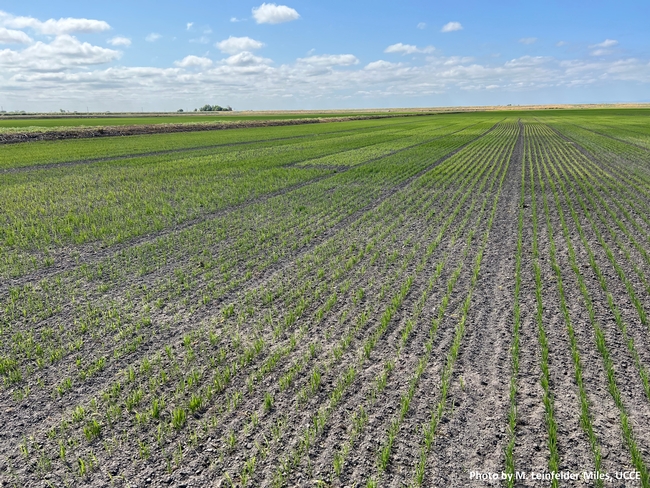
The trial was drill-seeded on April 27th at a rate of 150 lb/acre, and varieties were replicated three times as 150 ft2 plots. The trial was planted in a field of M-206, and fertility and pests were managed by the grower in the same manner as the field. We harvested the trial on October 12th, and yield was determined by hand-harvesting a 15 ft2 area from each plot.
Table 1 shows results from the Delta location (advanced breeding lines omitted). Among the entries, M-206 is the most commonly planted variety in the Delta and across the state. It has good agronomic characteristics and consistent quality across different harvest moistures. Some Delta growers also plant M-105, which is a very-early variety that has yielded well in Delta trials but may be slightly more susceptible to rice blast disease than M-206. Among the newer varieties, M-210 is early maturing, blast resistant, and may be a good option for the Delta. While variety M-211 performed well in 2023, it is not as well adapted to cooler environments as M-210 and has had variable performance over the last three years (Table 2). Also, M-211 quality tends to decrease below 18 percent harvest moisture. Statewide results of all nine testing locations will be available soon from the UC Rice Research and Information Center.
Special thanks go to the cooperating grower. Thanks also go to Bruce Linquist and Ray Stogsdill, UC Davis, for coordinating the statewide effort, and the CA Rice Research Board for funding. If you have questions about the trial or about Delta rice production, please don't hesitate to reach out to me, and good luck in 2024!
Table 1. 2023 Delta rice variety trial results.
Table 2. Three-year Delta trial yield summary (lb/acre at 14% moisture).
- Author: Michelle Leinfelder-Miles
Rice production in the Sacramento-San Joaquin Delta region has been steadily increasing in recent years. While Delta acreage is only a fraction of that in the Sacramento Valley, Delta yields are consistent with statewide averages. I estimate that in 2023, the Delta had around 10,000 acres of rice. In this seasonal recap, I'll overview UCCE research in Delta rice, as well as provide some observations about the 2023 season.
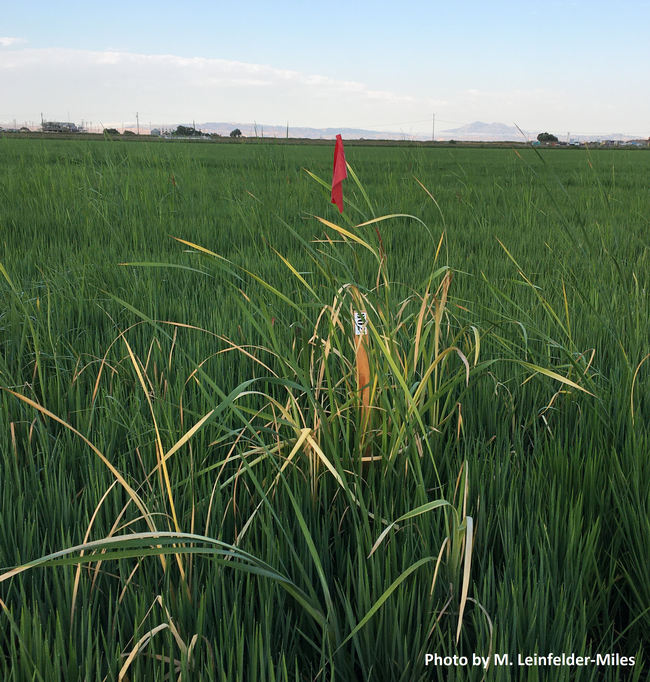
Armyworm Monitoring: I have been monitoring armyworm populations in the Delta since 2016, in collaboration with my UCCE colleague, Luis Espino. Monitoring involves scouting for damage and deployment of pheromone bucket traps that catch the moths. We can use trap counts and Growing Degree Day modelling (i.e. a temperature measure of time) to determine whether and when to treat fields. In 2023, we were thinking we might get away with minimal pressure because the population stayed low through early July. Then, the population spiked in mid-July, later than we had ever observed (Fig. 2). We surmise this was due to the cool, wet spring and later planting season. This year, Methoxyfenozide (Intrepid 2F) was available for use under full registration.
Disease Observations: We have identified diseases like stem rot, aggregate sheath spot, and rice blast on some Delta farms. It is important to scout for these diseases at late-tillering and early-heading because treatment timing is critical for management. Fungicide treatments are most effective when applied between late-boot and early-heading. Rice blast may be exacerbated by too much nitrogen, and stem rot and aggregate sheath spot by low potassium (K). K can be limiting in some Delta soils, especially where the straw is baled. There is a loss of approximately 28 lb K/ac for every ton of straw removed. Consider leaf tissue sampling for K between tillering and panicle initiation. The Y-leaf should have a K concentration of at least 1.5%. At heading, the flag leaf should have a K concentration of at least 1.2%. On-farm consultations are a service provided by UCCE. Please reach out if I can help identify pests and provide management guidelines.
Weedy Rice: We should continue to keep weedy rice on our radars because we have observed it in the Delta. In-season management includes rogueing or spot spraying before viable seed is produced. The organic herbicide Suppress is registered for spot spraying. Post-harvest management should include straw chopping, but not incorporation, and winter flooding. This will keep seed on the soil surface, where it can potentially deteriorate over the winter.
Variety Trial: UCCE collaborates with the California Rice Experiment Station to evaluate commercial varieties and advanced breeding lines. The San Joaquin County Delta location was one of ten locations in the 2023 statewide trial. The Delta is a test site for very-early maturing varieties because it has cooler growing conditions than other rice growing regions of the state. Variety trial results will be made available in the February 2024 newsletter.
Cover Cropping: With funding from the CDFA Healthy Soils Program and CA Rice Research Board, I am collaborating with Sara Rosenburg (UC Davis graduate student) and Whitney Brim-DeForest (UCCE rice advisor) to evaluate winter cover crops. We are interested to learn whether cover cropping improves soil carbon and nitrogen dynamics in the rice system. Since rice may be grown over multiple seasons without rotation, cover crops may provide an opportunity to introduce plant diversity, including nitrogen-fixing legumes. Trials will occur from 2022-2025, and the Delta site is one of three (also in Butte and Colusa counties). The 2022-2023 winter season presented several challenges for cover cropping. At the Delta location, seasonal rainfall exceeded 25 inches, and in the ten days after planting, the site received nearly 3.5 inches of rain. In addition to saturated soils, bird predation was severe. This fall, our aim is to plant earlier, if conditions allow.
Thank you to all the growers who collaborated with us on these projects. I wish everyone a good end to the year and a great 2024.


